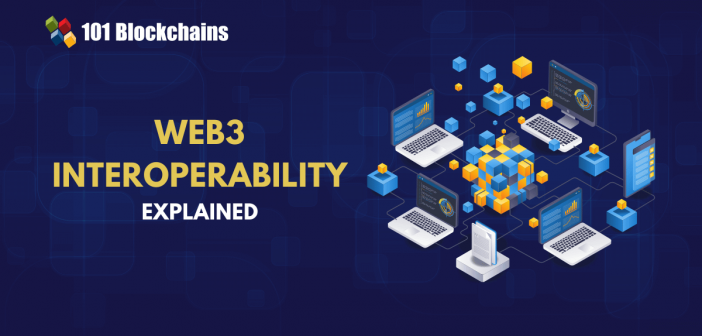Learn how blockchain truly works, master key definitions, and uncover what makes smart contracts so "smart." Dive into the fundamentals, gain valuable insights, and start your blockchain journey today!

- Web3
Georgia Weston
- on July 19, 2024
What’s Interoperability in Web3?
The internet has been moving towards a new era in which users would have more control over their digital experiences. Web3, the new generation of internet, leverages blockchain technology to create a user-centric and decentralized web. Interoperability is one of the crucial concepts that define the potential of web3 for inducing transformative changes. The importance of web3 interoperability becomes clearly evident from the troubles caused due to lack of interoperability in web2.
Interoperability is an essential requirement to ensure that different systems can exchange information with the help of a common framework. Web2 creates limitations for interoperability with isolated databases for each application. Interoperability may change things in web3 by enabling communication between dApps and web3 protocols. Learn more about the significance of interoperability and how it can change user experiences in web3.
Understanding the Fundamentals of Web3 Interoperability
The first aspect in any guide on interoperability would revolve around its definition. The review of answers to queries like ‘What is interoperability in web3?’ points at the flexibility for communication between different networks. Interoperability is the ability of blockchain networks to exchange information with each other. It helps in shattering the conventional precedents that involve blockchain networks working in isolation with their unique collection of smart contracts, rules and protocols.
The lack of interoperability serves as a barrier for seamless movement of assets and data across different blockchain networks. You would need interoperability in web3 to expand the capabilities of decentralized apps and web3 solutions. The concept of interoperability is similar to using an Amazon gift card to pay for a cup of coffee. Interoperability also serves critical advantages through the flexibility to transfer different types of digital assets between dApps on the same blockchain or between different blockchains.
Enroll now in the Blockchain Scalability and Interoperability Mastery Course to learn the skills needed to develop faster, scalable, robust, and interoperable dApps.
How Will Interoperability Look in the Real World?
Interoperability is one of the crucial factors that improves the utility and value of digital assets in web3. You can notice the best interoperability in web3 example in the domain of DeFi. Interoperability in DeFi can help in staking tokens, using them as collateral and exchanging them for other digital assets.
You can think of an interoperability example in a scenario where Starbucks and Spotify can enter into a partnership. Imagine that you can use the reward tokens of Starbucks to unlock special playlists on Spotify. In addition, interoperability between the NFT programs of these two brands can improve the NFTs of both brands with cross-platform utility.
Prominent Challenges for Interoperability in Web3
The concept of interoperability in web3 appears promising with its different advantages. Seamless communication and asset exchange between blockchain protocols, dApps and web3 solutions can open the doors for new opportunities. However, interoperability is still a distant reality for web3 owing to diverse challenges. A review of the prominent challenges for interoperability can help you find the ideal direction towards achieving true interoperability.
-
The Problem of Scalability
Scalability would emerge as a formidable concern in the domain of web3 as blockchain networks gain more users. The introduction of more blockchain networks would also create scalability issues. The growth in transaction volumes alongside increasing congestion of networks can interrupt the seamless transfer of data and assets between blockchain networks.
-
Ambiguity Regarding Incentives
Web3 projects might hesitate to make the move for achieving interoperability. The lack of clarity regarding incentives can create limitations for adopting interoperability standards. Therefore, it is important to establish frameworks that can offer the ideal rewards for data sharing and collaboration between blockchains. Rewards are more likely to encourage the rise of interoperable solutions in web3.
-
Lack of Standardization
The next prominent challenge for web3 interoperability is the lack of standardization in the protocols in blockchain networks. Therefore, web3 solutions do not have a universal communication language. Blockchain networks have their unique features, smart contract languages and consensus mechanisms that create barriers for interoperability.
-
Concerns for Web3 Security
Interoperability is responsible for introducing many new challenges for web3 security. The vulnerabilities or breaches in one blockchain could have a significant influence on the connected networks. The adoption of interoperability would depend on addressing the security and integrity of cross-chain transactions.
Establishing the Necessity of Interoperability
The reasons to introduce interoperability provide motivation to overcome different challenges. You can identify the necessity of interoperability in web3 in the highly fragmented nature of the blockchain ecosystem. Different blockchains have their unique advantages and features tailored for distinctive purposes. However, the fragmentation in the blockchain landscape creates silos and leads to different challenges.
The lack of interoperability restricts the functionalities of dApps to the blockchain they use. It is difficult to transfer the assets on one blockchain to another network. Most important of all, the lack of interoperability also has a negative impact on user experiences. Users have to navigate multiple interfaces, wallets and exchanges in the existing web3 landscape thereby creating complexities for users.
You can find different examples to understand the importance of interoperability for growth of web3. The utility of NFTs is limited as they can work only on specific blockchain networks and platforms. Interoperability can help NFTs access broader markets and new utilities. Interoperability can also help DeFi solutions by improving liquidity and offers a strong foundation for creating new DeFi apps.
Build your identity as a certified blockchain expert with 101 Blockchains’ Blockchain Certifications designed to provide enhanced career prospects.
How Will You Achieve Interoperability in Web3?
The importance of interoperability for the web3 ecosystem becomes clearly evident in the changes it can introduce for users and developers. It is also important to learn about the most effective solutions for achieving interoperability. Let us find out some of the most effective solutions to improve interoperability in different web3 solutions.
-
Cross-Chain Bridges
The first solution that comes to mind when you think of the concept of interoperability in web3 is a cross-chain bridge. Cross-chain bridges serve as connectors between different blockchain networks for transferring data and assets. The bridges can leverage different mechanisms like hashed time-locked contracts to achieve verifiable and secure transactions across blockchains.
-
Innovative Incentive Mechanisms
Web3 projects can adopt interoperability when they have the assurance of unique incentive mechanisms. The most effective incentive mechanisms to achieve web3 interoperability include liquidity provision, staking rewards and token swaps. The incentives can help in developing symbiotic relationships between the interconnected networks.
-
Sidechains and Layer 2 Scaling Solutions
Sidechains are another prominent example of interoperability solutions for web3. They are unique secondary blockchain networks that offer the security of the primary blockchain alongside improving interoperability and scalability. Layer 2 scaling solutions can address the concerns of scalability that might hinder the adoption of interoperability.
-
Atomic Swaps
Atomic swaps are another effective addition to an interoperability in web3 example list for their unique functionality. They ensure direct exchange of assets between blockchains without involving intermediaries. The trustless mechanism in atomic swaps eliminates counterparty risks.
-
Oracles
Decentralized oracles might also serve as formidable catalysts for the growth of interoperability in the web3 ecosystem. Oracles are third-party services that collect data from external sources and verify the data for integrity and correctness. Web3 solutions can leverage oracles for seamless communication with different blockchain networks.
-
Interoperability Protocols
Interoperability protocols are effective solutions for development of standardized protocols. The standardized protocols can ensure seamless communication between blockchains thereby offering the assurance of interoperability. Interoperability protocols work by defining a common collection of rules for executing smart contracts and ensuring effective data exchange.
Curious to develop an in-depth understanding of web3 application architecture? Enroll now in the Web3 Application Development Course
Shaping the Future Prospects for Web3 Interoperability
The evolution of the blockchain space indicates promising opportunities for the growth of web3. The responses to queries like “What is interoperability in web3?” help you understand how interoperability would play a major role in determining the future of decentralized web. It is important to observe the most impactful developments for achieving interoperability that would determine the future of interoperability.
-
Growth of Multi-chain Platforms
Multi-chain platforms have emerged as the most effective examples of interoperability. Some of the popular choices such as Avalanche, Polkadot and Cosmos have been successfully addressing interoperability challenges. The platforms serve as the hubs for connecting different blockchains to create a connected ecosystem.
-
Maturity of Interoperability Solutions
The growth of interoperability in web3 in the future would depend on maturity of different interoperability solutions. Maturity of the web3 ecosystem would open new prospects for improving security and functionalities of interoperability solutions. The advancements in interoperability solutions would be driven by innovative advancements in cross-chain communication protocols, cryptographic techniques and consensus algorithms.
-
Measures to Push for Standardization
The future of interoperability would depend largely on the fight against standardization challenges. Web3 can witness true interoperability with common standards for all web3 protocols. The collaboration between industry players and web3 communities would play a crucial role in empowering efforts for standardization.
Build your fluency in Web3 and develop decentralized solutions with the world’s first Web3 Expert Career Path with quality resources tailored by industry experts Now!
Final Thoughts
The necessity of web3 interoperability becomes more evident in the era of web3 growth. You can notice many web3 solutions such as NFTs and metaverse projects gaining mainstream attention. However, the potential of web3 is restricted due to the silos in which different web3 solutions operate. It is important to understand the concept of interoperability and the challenges for achieving interoperability in the field of web3.
The pursuit for standardization would lead web3 solutions towards promising improvements in interoperability. Web3 projects must also pay attention to the effective use of different interoperability solutions such as cross-chain communication protocols and interoperability protocols. Learn more about interoperability and find how it can transform the web3 landscape with innovative developments.
*Disclaimer: The article should not be taken as, and is not intended to provide any investment advice. Claims made in this article do not constitute investment advice and should not be taken as such. 101 Blockchains shall not be responsible for any loss sustained by any person who relies on this article. Do your own research!







